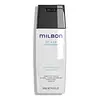What's inside
What's inside
 Key Ingredients
Key Ingredients

No key ingredients
 Benefits
Benefits

 Concerns
Concerns

 Ingredients Side-by-side
Ingredients Side-by-side

Water
Skin ConditioningSodium Laureth Sulfate
CleansingPPG-2 Cocamide
Lauramidopropyl Betaine
CleansingMyristamidopropyl Betaine
CleansingIsostearoyl Hydrolyzed Silk
Skin ConditioningHydrolyzed Hyaluronic Acid
HumectantMenthyl PCA
HumectantMenthol
MaskingPolyquaternium-10
Polyquaternium-52
Sodium Lauroyl Methylaminopropionate
CleansingSodium Laureth-11 Carboxylate
CleansingLaureth-16
EmulsifyingDihydroxypropyl Arginine Hcl
HumectantDiospyros Kaki Fruit Extract
Skin ConditioningSodium Carbonate
BufferingSodium Bicarbonate
AbrasiveDipotassium Glycyrrhizate
HumectantIsostearic Acid
CleansingCitric Acid
BufferingButylene Glycol
HumectantPotassium Hydroxide
BufferingBHT
AntioxidantDisodium EDTA
Etidronic Acid
Pentasodium Pentetate
Chloramine T
AntimicrobialMethylisothiazolinone
PreservativeMethylchloroisothiazolinone
PreservativeParfum
MaskingLimonene
PerfumingLinalool
PerfumingWater, Sodium Laureth Sulfate, PPG-2 Cocamide, Lauramidopropyl Betaine, Myristamidopropyl Betaine, Isostearoyl Hydrolyzed Silk, Hydrolyzed Hyaluronic Acid, Menthyl PCA, Menthol, Polyquaternium-10, Polyquaternium-52, Sodium Lauroyl Methylaminopropionate, Sodium Laureth-11 Carboxylate, Laureth-16, Dihydroxypropyl Arginine Hcl, Diospyros Kaki Fruit Extract, Sodium Carbonate, Sodium Bicarbonate, Dipotassium Glycyrrhizate, Isostearic Acid, Citric Acid, Butylene Glycol, Potassium Hydroxide, BHT, Disodium EDTA, Etidronic Acid, Pentasodium Pentetate, Chloramine T, Methylisothiazolinone, Methylchloroisothiazolinone, Parfum, Limonene, Linalool
Water
Skin ConditioningSodium Coco-Sulfate
CleansingGlycerin
HumectantBabassuamidopropyl Betaine
CleansingRosmarinus Officinalis Leaf Extract
AntimicrobialHelianthus Annuus Seed Oil
EmollientMentha Piperita Oil
MaskingMenthol
MaskingCamphor
MaskingStearamidopropyl Dimethylamine
EmulsifyingSodium Gluconate
Skin ConditioningPolyquaternium-4
Vinegar
Sodium Chloride
MaskingCitric Acid
BufferingCocamidopropylamine Oxide
CleansingParfum
MaskingLinalool
PerfumingLimonene
PerfumingIsoeugenol
PerfumingBenzoic Acid
MaskingPhenoxyethanol
PreservativeSodium Benzoate
MaskingWater, Sodium Coco-Sulfate, Glycerin, Babassuamidopropyl Betaine, Rosmarinus Officinalis Leaf Extract, Helianthus Annuus Seed Oil, Mentha Piperita Oil, Menthol, Camphor, Stearamidopropyl Dimethylamine, Sodium Gluconate, Polyquaternium-4, Vinegar, Sodium Chloride, Citric Acid, Cocamidopropylamine Oxide, Parfum, Linalool, Limonene, Isoeugenol, Benzoic Acid, Phenoxyethanol, Sodium Benzoate
Alternatives
Ingredients Explained
These ingredients are found in both products.
Ingredients higher up in an ingredient list are typically present in a larger amount.
Citric Acid is an alpha hydroxy acid (AHA) naturally found in citrus fruits like oranges, lemons, and limes.
Like other AHAs, citric acid can exfoliate skin by breaking down the bonds that hold dead skin cells together. This helps reveal smoother and brighter skin underneath.
However, this exfoliating effect only happens at high concentrations (20%) which can be hard to find in cosmetic products.
Due to this, citric acid is usually included in small amounts as a pH adjuster. This helps keep products slightly more acidic and compatible with skin's natural pH.
In skincare formulas, citric acid can:
While it can provide some skin benefits, research shows lactic acid and glycolic acid are generally more effective and less irritating exfoliants.
Most citric acid used in skincare today is made by fermenting sugars (usually from molasses). This synthetic version is identical to the natural citrus form but easier to stabilize and use in formulations.
Read more about some other popular AHA's here:
Learn more about Citric AcidLimonene is a fragrance that adds scent and taste to a formulation.
It's found in the peel oil of citrus fruits and other plants such as lavender and eucalyptus. The scent of limonene is generally described as "sweet citrus".
Limonene acts as an antioxidant, meaning it helps neutralize free radicals.
When exposed to air, oxidized limonene may sensitize the skin. Because of this, limonene is often avoided by people with sensitive skin.
The term 'fragrance' is not regulated in many countries. In many cases, it is up to the brand to define this term. For instance, many brands choose to label themselves as "fragrance-free" because they are not using synthetic fragrances. However, their products may still contain ingredients such as essential oils that are considered a fragrance.
Learn more about LimoneneLinalool is a fragrance and helps add scent to products. It's derived from common plants such as cinnamon, mint, citrus, and lavender.
Like Limonene, this ingredient oxidizes when exposed to air. Oxidized linalool can cause allergies and skin sensitivity.
This ingredient has a scent that is floral, spicy tropical, and citrus-like.
Learn more about LinaloolMenthol is a compound found in mint plants, such as peppermint. In its pure form, it is a clear crystalline substance.
Menthol is known for its cooling sensation; however, the cooling is actually from your skin being sensitized. Menthol can worsen rosacea. We recommend speaking with a professional if you have concerns.
Menthol also has antimicrobial properties.
Learn more about MentholParfum is a catch-all term for an ingredient or more that is used to give a scent to products.
Also called "fragrance", this ingredient can be a blend of hundreds of chemicals or plant oils. This means every product with "fragrance" or "parfum" in the ingredients list is a different mixture.
For instance, Habanolide is a proprietary trade name for a specific aroma chemical. When used as a fragrance ingredient in cosmetics, most aroma chemicals fall under the broad labeling category of “FRAGRANCE” or “PARFUM” according to EU and US regulations.
The term 'parfum' or 'fragrance' is not regulated in many countries. In many cases, it is up to the brand to define this term.
For instance, many brands choose to label themselves as "fragrance-free" because they are not using synthetic fragrances. However, their products may still contain ingredients such as essential oils that are considered a fragrance by INCI standards.
One example is Calendula flower extract. Calendula is an essential oil that still imparts a scent or 'fragrance'.
Depending on the blend, the ingredients in the mixture can cause allergies and sensitivities on the skin. Some ingredients that are known EU allergens include linalool and citronellol.
Parfum can also be used to mask or cover an unpleasant scent.
The bottom line is: not all fragrances/parfum/ingredients are created equally. If you are worried about fragrances, we recommend taking a closer look at an ingredient. And of course, we always recommend speaking with a professional.
Learn more about ParfumWater. It's the most common cosmetic ingredient of all. You'll usually see it at the top of ingredient lists, meaning that it makes up the largest part of the product.
So why is it so popular? Water most often acts as a solvent - this means that it helps dissolve other ingredients into the formulation.
You'll also recognize water as that liquid we all need to stay alive. If you see this, drink a glass of water. Stay hydrated!
Learn more about Water